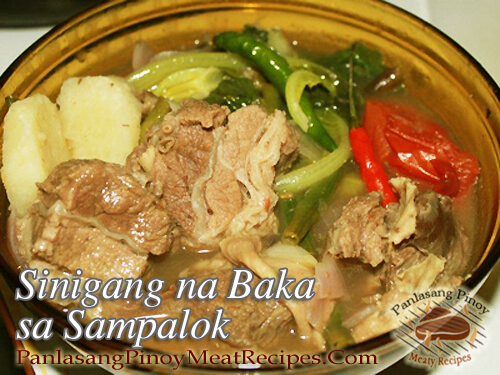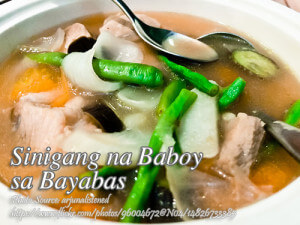Sinigang na baka sa sampalok is a tamarind based beef soup. Like the usual sinigang dish, this recipe use tamarind to make the soup sour. This dish taste better for those who don’t like to eat pork since it uses beef. Preparation of the tamarind broth is a not tedious and in fact very simple. And it taste better than commercial sinigang mix in powdered or in liquid form.
A Taste of Nostalgia: Sinigang na Baka sa Sampalok
Growing up, the aroma of sour broth simmering on the stove was always a comforting reminder that a hearty meal was on the way. One of my absolute favorites, a dish that brings me back to countless family gatherings, is beef sinigang. Unlike the more commonly prepared pork version, this recipe uses tender beef, slowly simmered in a tamarind-based broth, to create a savory and tangy delight. My grandmother, or lola, swore by using fresh sampalok whenever possible, insisting that it made all the difference. And as much as I loved helping her in the kitchen, the highlight was always sipping the broth she perfected with years of practice.
The Essence of Fresh Sampalok
Sinigang, in all its variations, is a staple of Filipino households, but what makes this version unique is the use of fresh tamarind. For many, it might seem easier to grab a commercial sinigang mix, but trust me, if you’ve never made the broth from scratch, you’re missing out on something special. My lola had a deep connection to her ingredients, and when it came to preparing this sour soup, she wouldn’t settle for shortcuts.
Boiling fresh tamarind to make the broth might seem intimidating for beginners, but it’s actually quite simple. The process involves simmering the tamarind pods in water until they soften, then mashing them to release their sour essence. The broth that comes from this process is lighter, more natural, and has a depth of flavor that just can’t be replicated by pre-made mixes. Whenever I make it this way, it’s like my kitchen fills with the same warmth and care my grandmother poured into every meal.
The Perfect Beef for Sinigang
My family wasn’t big on pork, so my uncle suggested that we swap out the usual pork ribs for beef. It was an experiment at first, but after one bite, we were hooked. The beef, when simmered slowly, becomes incredibly tender and soaks up all the tangy goodness of the broth. My uncle was right—there’s something special about the way the flavors blend with beef.
To get the perfect texture, I follow my grandmother’s tip of boiling the beef initially to remove any impurities, giving the broth a cleaner taste. Once the beef is rinsed and boiled again, it’s cooked just until tender, which is crucial. Overcooking can leave you with dry, tough meat, while undercooking won’t allow the meat to absorb the richness of the soup. Every time I prepare it this way, I’m reminded of family dinners where we’d sit around the table, passing bowls of this hearty stew while discussing the day’s events.
Vegetables That Complete the Dish
One of the beautiful things about this dish is how adaptable it is, and the vegetables you add can change depending on what’s fresh or available. For me, gabi (taro), sitaw (string beans), and labanos (radish) are must-haves. They not only add texture and variety but also soak up the rich, sour broth, making each bite more flavorful. My sister, who now lives in the province, always tells me how she adds kangkong (water spinach) right at the end, just like our mom did. The leafy greens give the dish a slight bitterness that balances out the sourness perfectly.
Each vegetable has its own purpose in the pot. The gabi thickens the broth slightly, making it heartier, while the radish and string beans provide a crisp contrast to the tender beef. And of course, the final touch—the green chili. Adding this gives a subtle heat, which my brother always loved. He would joke that the spicier, the better, but for me, just one or two chilies gives the dish the right amount of warmth without overpowering the tangy broth.
A Dish Steeped in History
Sinigang has been a part of Filipino cuisine for centuries. While no one knows exactly when it first appeared, it’s believed to have originated as a way to make the most of sour fruits available in the local landscape, such as sampalok, kamias, or even green mangoes. The use of these souring agents was a practical way for Filipinos to enhance the flavor of soups, especially since refrigeration was scarce. Over time, this dish evolved, with each household adding its own twist, whether that’s using different meats or vegetables.
Beef in tamarind broth may not be the most traditional version, but it has become a beloved variation, particularly for those who prefer a richer and heartier taste than what pork offers. My family embraced this variation early on, and it’s now a tradition I continue in my own home.
Serving Up Comfort
There’s something undeniably comforting about a bowl of this hearty soup. The sourness from the tamarind, the tender beef, the mix of vegetables—it’s the kind of dish that brings people together. Whether served during a rainy afternoon or as the star of a weekend family gathering, it never fails to warm both the body and the soul.
Whenever I prepare this beef version, I can’t help but think of those long afternoons spent in the kitchen with my lola, carefully mashing the tamarind and simmering the beef just right. It’s more than just a meal—it’s a reminder of where we come from, of family, and of the comforting power of food.
So the next time you’re looking to try something new or impress your family with a dish that’s both familiar and slightly different, give this beef sinigang a try. Just be ready for everyone to ask for seconds.
How to Cook Sinigang na Baka sa Sampalok (Beef in Tamarind Broth)
Ingredients
- 1 kilo beef brisket or cut into cubes
- 150 grams tamarind fruit or 1 pack Sinigang sa Sampalok mix
- 1 bunch kangkong wash and get the leaves only
- 1 pc radish
- 1 bunch string beans
- 3 pcs siling haba or green chili
- 250 grams taro root or gabi
- 2 pc medium size tomatoes chopped
- 1 pc large red onion quartered
- salt and patis
Instructions
How to cook Sinigang na Baka sa Sampalok:
- Boil the tamarind in a pot with water, about 3 cups, adjust if necessary. Cook until the tamarind becomes tender.
- Remove the tamarind from the pot and transfer to a bowl then mash it with a fork until the juices comes out.
- Then put it again in the pot and stir. Strain the contents of the pot with a colander and pour it a another container to get the broth from the tamarind. Press it until the juices have been extracted.
- In another pot boil the beef for about 5 minutes. Remove the liquid and scum then wash the meat.
- Then replace the water by filling the pot just enough to cover the meat.
- Boil until the meat is cooked and tender.
- Add in the salt, onion, tomatoes and gabi. Boil until the gabi is cooked.
- Then add in the string beans and radish. Simmer for about 3 minutes.
- Pour the tamarind broth (or if you can't find tamarind, use sinigang mix), kangkong leaves and green chili.
- Season with salt or fish sauce (patis) and serve hot.
Notes
Cooking Tips:
Use Fresh Tamarind for Authentic Flavor
While sinigang mixes are convenient, fresh tamarind gives the broth a richer and more natural sourness. To extract the tamarind juice, simmer the pods until soft, then mash and strain the pulp. This simple step elevates the dish and brings out a more authentic, homemade taste.Pre-Boil the Beef for Cleaner Broth
Before cooking the beef fully, boil it briefly and discard the first batch of water to remove impurities and excess fat. This ensures that your broth stays clear and free of unwanted scum. It also enhances the overall flavor of the soup, keeping it fresh and light.Add Vegetables at the Right Time
To keep your veggies crisp and vibrant, add them to the pot based on their cooking times. Root vegetables like gabi should go in early, while tender greens like kangkong and string beans should be added last. This preserves their texture and prevents them from becoming mushy.






I want to try this… Thank you for sharing
Hi Myrna, I glad that you like the recipe! Thanks also for visiting!